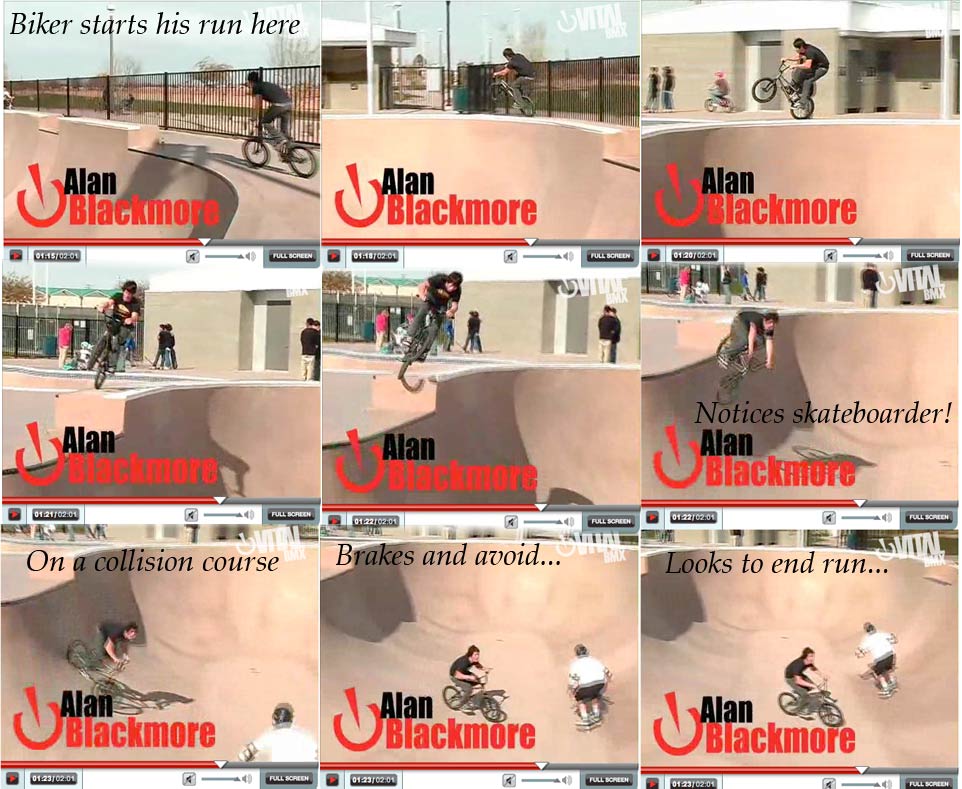- 1) The Displacement factor
- There are more than 10 million skateboarders in the USA alone, and not nearly enough skateboard facilities for us. Skateboarders require generally smooth surfaces so our 55-millimeter wheels can roll on them unlike bikes, which can ride anywhere. Add to this the number of BMX And Mountain bikers who choose to ride skateparks.
The net result is that someone has to go. There simply isn't enough room for all the skateboarders and all the bike riders. What ends up happening, is the younger more vulnerable skaters get pushed out. Bikers go faster and higher than skateboarders. The obvious conclusion of any skater is that danger lurks just around the corner for those willing to drop in, and ride with them.
For the younger or inexperienced skater, this means either take a huge risk and try and skate with them, or leave. Many times they leave, either because they are intimidated, or because their parents don't feel it's safe. This is called displacement. One activity (kids skating) is being displaced by another activity (bikes).
This is an issue that is easy to observe at the skatepark, but it's difficult to take a photo of people leaving the skatepark that shows displacement, or people who drive into the parking lot, only to leave a few seconds later. Or people who don't even frequent their local skatepark anymore, due to the experiences and knowledge that bikes have taken the park over. So, even though this is occurring everyday, it's difficult to document a few quotes from Kent Dahlgren illustrate the problem.
West Linn, Oregon
West Linn, 10:00 am on a summer weekday. West Linn moms drink $3 cups of coffee while their children play in the skatepark. The park is opened to BMX till noon so bikers swarm the place - all of who actually aren't residents of West Linn. Moms pack kids up after a few close-calls and shuttle them off to the nearby playground, 3 blocks away. Kids skate around playground instead.
This isn't fiction. While I went to West Linn to watch BMXers when they were first invited into the park, to make sure they actually went without pegs, I ended up repeatedly following the kids to the adjacent park. It was fascinating. In fact, a friend of mine is one of these West Linn moms. She has 4 kids, Andy is her eldest, at 9 or something. She, like many of the moms, stopped taking their kids to West Linn, because of the bikes.
Calgary, Canada
Street skaters chill in this relatively high spot, and about 8-10 of them take turns doing what could only be considered highly impressive freestyle tricks. Now and then they roll down through the hubbas rails ledges and so on, then come back, and do it all again. But the platform is where they session.
On the back side of one of the platform's "walls," there is a roll in to this large relatively flat flow area. This area is actually so large that skaters have to kick just to get through it, even though they've rolled in. The bikers, given their ability for speed, are all over that, and when the mountain bikers come out of this area, they roll onto the top of the platform, thus running into the skaters who are, in their opinion, are "just standing around."
I went and talked to the mountain bikers and they complained that the kids could sit on the ledge or stand closer to where they are going to "drop in," but because they didn't appreciate the importance of a "roundtable" freestyle session that happens to include rolling lines through a side street area, they simply saw the kids as standing around intentionally trying to get in the way.
So what do they do? They just roll through, repeatedly, until the skaters move out of their way or until they leave. Which is exactly what happened this evening. The attached camera phone shot says it all about Canadian skater/biker harmony, which is sprayed at the top of the platform, facing where the bikers are.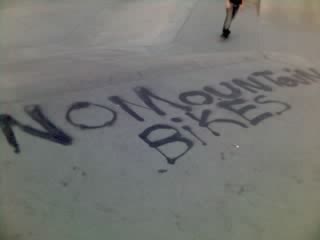
The most used area in the park, the section that was literally packed with kids, was probably no larger than 5,000 sq/ft. I spoke of it earlier: hubbas, stairs, etc. Plus the "flat" areas on either side are host to "round table" freestyle sessions.
I spoke with many of the kids here and they said that this park is where they hang, and kill time until the sun goes down and they can go street skating "in the wild." In fact, that's what every kid I spoke to was doing: killing time.
So I asked: why not just do it here? Their answers: - Bikes constantly threaten to run them over, whereas in the streets they can session with very few worries of getting hurt due to someone else's recklessness.
Fascinating, if you consider it, that kids would rather risk running into cars and the police over bikes, but if you watch the bikes in this park, you begin to understand why. By the time I roll down one bank a biker has covered nearly half the park, and given their speed, only fancies me some slow thing that's in the way. More than one skidded their tires at me.
The general conclusion is that skaters outnumber bikers by many times. They are, on average, 14 years old and therefore the "at risk" kids we always talk about taking care of. In fact, the reason cities plan skateparks is due to gaggles of kids riding skateboards, not bikes, right?
Consider: for the same reason sidewalks are safe for pedestrians by creation of bike lanes, allowing bikes and autos to co-exist, skateparks should also be segregated to protect the safety of the primary user group: children on skateboards, NOT the recreational right of 24 year old adults.
We advocate for kids; we are their mouthpiece. Consider what we are saying: we are talking safety; they are talking rights.
Net Result: Skateboarders are pushed out or back into the streets.
- 2) The Danger Factor
- The danger factor is another issue that is hard to document, but is intuitive to any skateboarder. The same reason that Mt. Bikes aren't allowed on many hiking trails, is the same reason that bikes are dangerous to skateboarders in the same skatepark.
Here's a rare photo of a collision of skater with a bike. It's not that collisions don't happen, it's that they are hard to capture on film.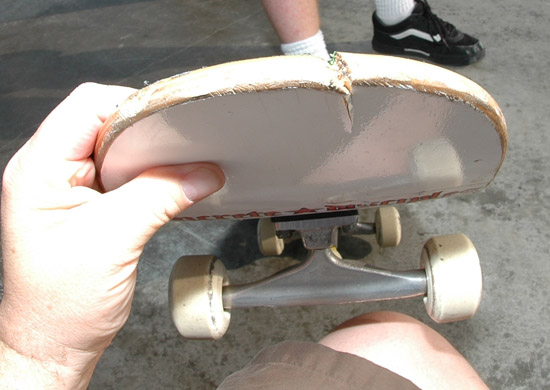 Couple the speeds with the sharp edges of a bike, and again, something will have to give, and it's usually the skateboarder.
Couple the speeds with the sharp edges of a bike, and again, something will have to give, and it's usually the skateboarder.
This next photo was taken after a collision, consider what can happen when a skateboard collides with a bike. Imagine this was someone's leg. Collisions do happen, but when collisions happen with bikes. It's the skateboarder who takes the worst of it.
Here is a little internet movie that illustrates the speeds and heights bikers can go which only illustrate the danger factor represented to those who might accidentally collide with them.
BMX riders will say that there is no danger factor, but consider this article from the Springfield News, Oregon. "Jesse Eisel, 16, soars over the concrete at Willamalane Skate Park at an altitude of roughly 12 feet as his BMX bike wobbles off below in a different direction. Despite performing this very technically challenging move without any protective gear, Jesse landed on his feet, rolled forward and claimed to be uninjured. For riders who are less lucky than Jesse, this sort of riding can be very painful and expensive without at least elbow pads, knee pads, gloves and a helmet.
Or bike advocate Cedar Keyes said in the Portland Tribune (Oregon):
"Having grown up skateboarding, it is dangerous when BMX bikers come in the park," he said. "They're heavy, they're fast, they have sharp metal objects protruding everywhere; it can be dangerous, and there can be collisions."
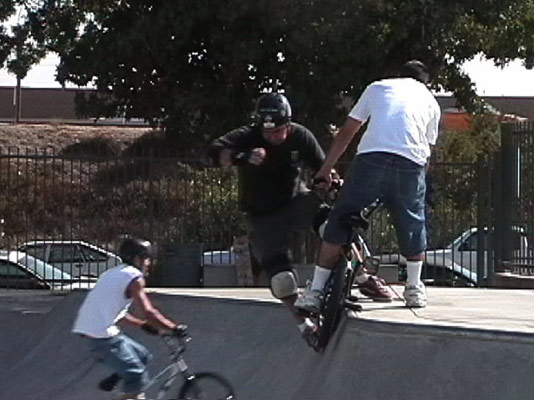
Opening day at this park in the UK, this was captured: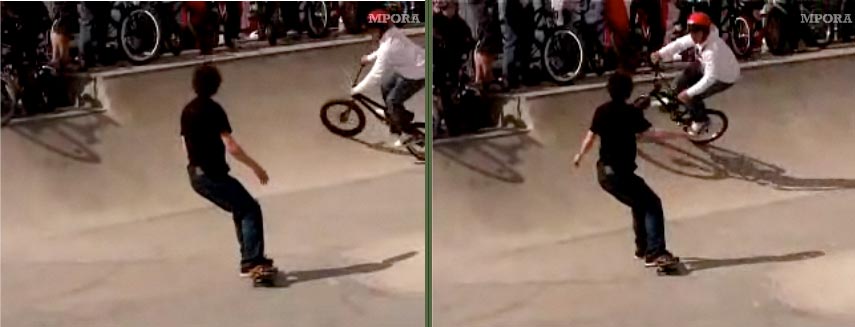 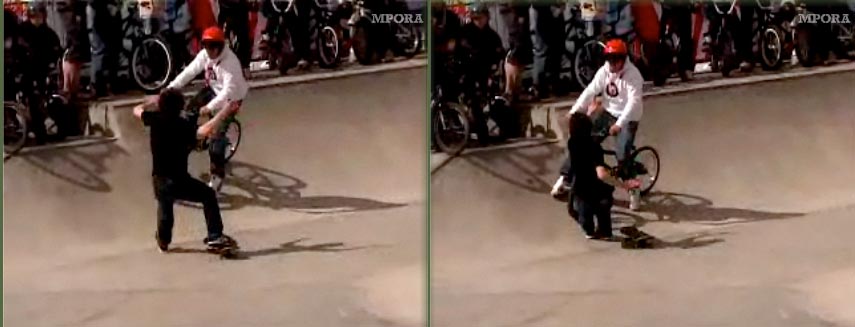 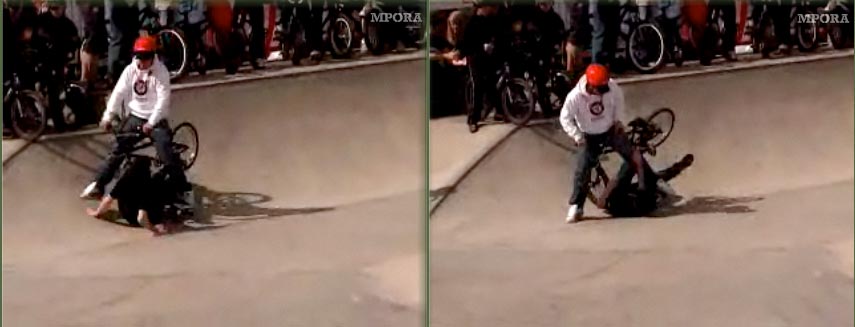 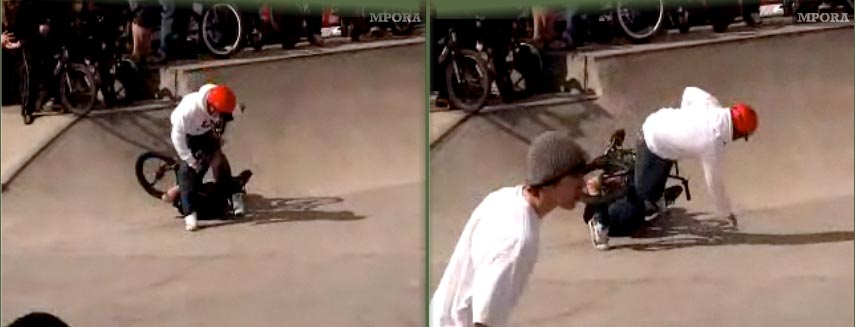 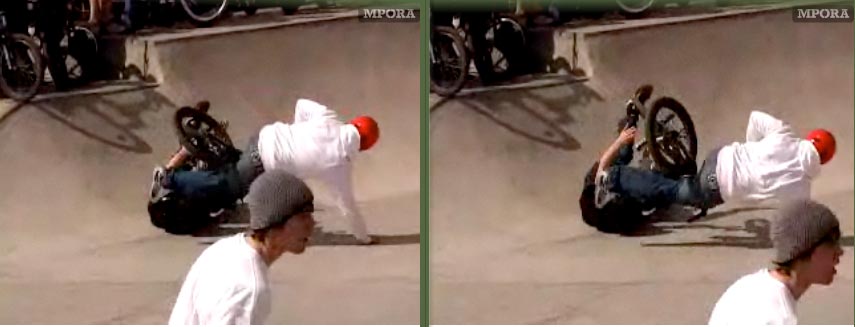 See original movie click here No matter who is at fault, the Skateboarder pays the price for the collision. The sharp objects on a bike are dangerous when impacting a skater. What if the bike had pegs? The skater gets the worst of the collision once again. The net result is displacement, because who wants to deal with this amount of danger just to ride? |
- 3) Damage Factor
- While Damage is easy to document; it's also the easiest issue to deal with and can be mitigated by maintenance, and design. So, while it's easy to deal with, it is still an important issue because the damage effects skateboarders, it doesn't effect bikers. With our small wheels, we are the ones who will get tripped up on a chunk or chip in the concrete. Here are some old shots of damage done by bikes:
Damage seen at Sumner, WADamage at Bayonne skatepark in NJ
Damage at Harada Skatepark, California
Scottsdale, AZ - FAQ Page shows bike damage and lists why bikes aren't allowed.
